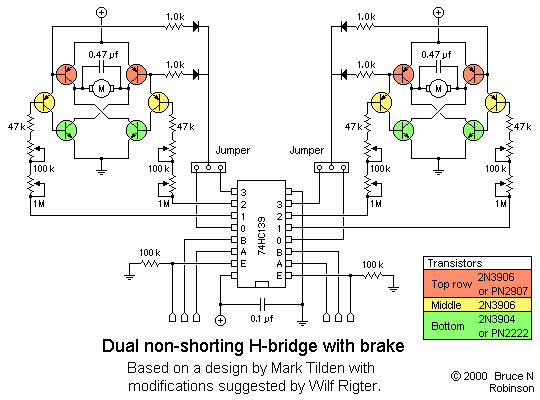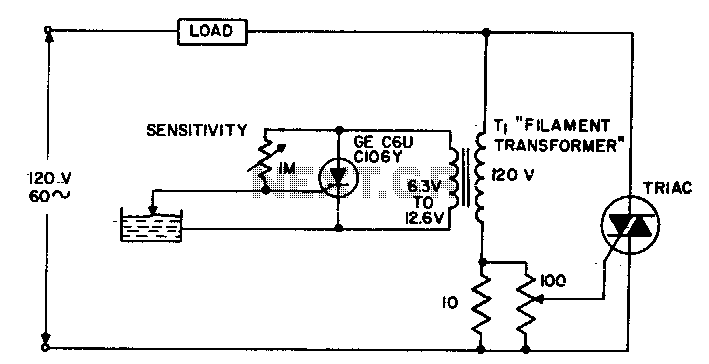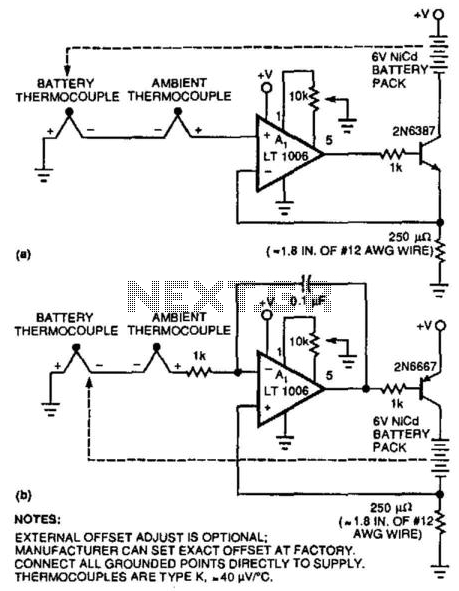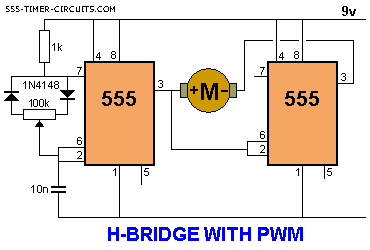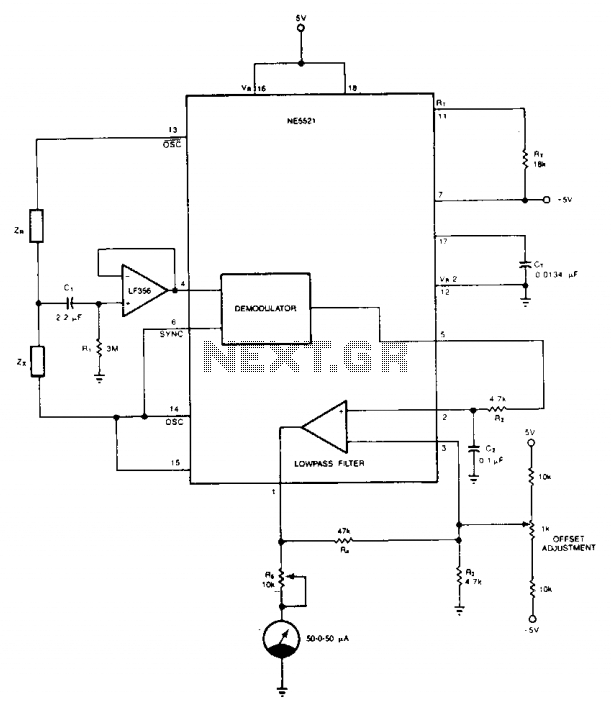
Air-Flow Sensing Thermistor Bridge

Using a thermistor-bridge circuit, it is possible to detect air losses in system cooling caused by filter or inlet blockage or fan failure. One thermistor is placed directly in the airflow, while the other is shielded. The exposed thermistor measures the temperature within the cooling system, whereas the baffled thermistor measures the ambient temperature in still air. As long as the temperatures of the thermistors differ, the bridge remains unbalanced, and the circuit outputs a logical high, indicating that the cooling system is functioning correctly. If airflow ceases, the exposed thermistor will equalize to the ambient temperature, the bridge will balance, and the circuit will signal a ventilation system failure by outputting a logical low. The matched thermistors in the bridge circuit are powered by matched current sources. Two LM10C operational amplifiers serve as constant-current sources, while an LM311 comparator detects the voltage difference across the thermistors, producing a logical high when the bridge is unbalanced and a logical low when balanced. A 20-kOhm potentiometer is used to adjust the comparator's threshold, which defines the minimum airflow required to generate a logical high output.
The thermistor-bridge circuit is an effective solution for monitoring the performance of cooling systems in various applications, including HVAC systems and electronic equipment cooling. The configuration consists of two thermistors, where one is directly exposed to the airflow and the other is shielded from direct air contact. This arrangement allows for the detection of temperature differentials that indicate airflow status.
The operational amplifiers (LM10C) are configured to provide constant current to the thermistors, ensuring that their performance is stable and reliable under varying temperature conditions. The LM311 comparator plays a crucial role in evaluating the voltage across the thermistors. When the airflow is adequate, the temperature readings from the thermistors will differ, resulting in an unbalanced voltage output that drives the comparator to a logical high state. Conversely, if airflow is obstructed, the exposed thermistor will reach the same temperature as the baffled thermistor, leading to a balanced output and a subsequent logical low signal from the comparator.
The inclusion of a 20-kOhm potentiometer allows for fine-tuning of the comparator's threshold level, enabling the circuit to be calibrated for specific airflow requirements. This feature is particularly advantageous in applications where varying environmental conditions may affect the cooling efficiency.
In practical implementation, the circuit can be integrated into a monitoring system that alerts operators to potential cooling failures, thereby preventing overheating and subsequent damage to system components. The thermistor-bridge circuit is a cost-effective and reliable method for ensuring optimal airflow in cooling systems, contributing to the longevity and efficiency of electronic devices and systems. Using the thermistor-bridge circuit, you can detect system-cooling air losses caused by filter or inlet blockage or fan failure. One thermistor is mounted directly in the air flow; the other is baffled. The exposed thermistor senses the temperature in the cooling system; the baffled thermistor senses the ambient temperature in still air. As long as the thermistors are at different temperatures, the bridge stays unbalanced and the circuit produces a logical high, indicating that the cooling system is working.
If the air flow stops, the exposed thermistor will reach ambient temperature, the bridge will become balanced, and the circuit will indicate ventilation-system failure by producing a logical low. The bridge circuit"s matched thermistors are biased by matched-current sources. Two LM10C operational amplifiers act as constant-current sources, and an LM311 comparator senses the difference between the voltage drops across the thermistors, producing the logical high when the bridge is unbalanced and the logical low when the bridge is balanced.
Use a 20-KOhmhm potentiometer to set the comparator"s threshold; this setting determines the minimum air flow that will cause the circuit to produce a logical high.
The thermistor-bridge circuit is an effective solution for monitoring the performance of cooling systems in various applications, including HVAC systems and electronic equipment cooling. The configuration consists of two thermistors, where one is directly exposed to the airflow and the other is shielded from direct air contact. This arrangement allows for the detection of temperature differentials that indicate airflow status.
The operational amplifiers (LM10C) are configured to provide constant current to the thermistors, ensuring that their performance is stable and reliable under varying temperature conditions. The LM311 comparator plays a crucial role in evaluating the voltage across the thermistors. When the airflow is adequate, the temperature readings from the thermistors will differ, resulting in an unbalanced voltage output that drives the comparator to a logical high state. Conversely, if airflow is obstructed, the exposed thermistor will reach the same temperature as the baffled thermistor, leading to a balanced output and a subsequent logical low signal from the comparator.
The inclusion of a 20-kOhm potentiometer allows for fine-tuning of the comparator's threshold level, enabling the circuit to be calibrated for specific airflow requirements. This feature is particularly advantageous in applications where varying environmental conditions may affect the cooling efficiency.
In practical implementation, the circuit can be integrated into a monitoring system that alerts operators to potential cooling failures, thereby preventing overheating and subsequent damage to system components. The thermistor-bridge circuit is a cost-effective and reliable method for ensuring optimal airflow in cooling systems, contributing to the longevity and efficiency of electronic devices and systems. Using the thermistor-bridge circuit, you can detect system-cooling air losses caused by filter or inlet blockage or fan failure. One thermistor is mounted directly in the air flow; the other is baffled. The exposed thermistor senses the temperature in the cooling system; the baffled thermistor senses the ambient temperature in still air. As long as the thermistors are at different temperatures, the bridge stays unbalanced and the circuit produces a logical high, indicating that the cooling system is working.
If the air flow stops, the exposed thermistor will reach ambient temperature, the bridge will become balanced, and the circuit will indicate ventilation-system failure by producing a logical low. The bridge circuit"s matched thermistors are biased by matched-current sources. Two LM10C operational amplifiers act as constant-current sources, and an LM311 comparator senses the difference between the voltage drops across the thermistors, producing the logical high when the bridge is unbalanced and the logical low when the bridge is balanced.
Use a 20-KOhmhm potentiometer to set the comparator"s threshold; this setting determines the minimum air flow that will cause the circuit to produce a logical high.
